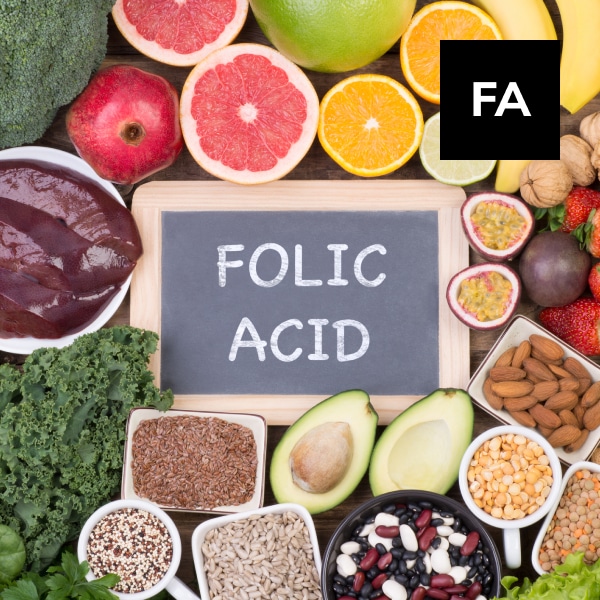Overview
Folate, also known as vitamin B9, is a B vitamin that occurs naturally in a variety of foods. Folic acid is the form of folate added to vitamin supplements and fortified foods by manufacturers.
It is vital for making healthy red blood cells, preventing neural tube defects in developing babies, for the synthesis and repair of DNA, and for cell division. Although most people get enough in their diet, pregnant women and women who plan to get pregnant should take a folic acid supplement.
Key Benefits
- Supports healthy blood
- Reduces risk of anemia
- Supports healthy infant development
- Prevents neural tube defects
- Supports synthesis and repair of DNA
- Helps reduce homocysteine levels that may lead to cardiovascular disease
History of Usage
The relationship between folate deficiency and the occurrence of neural tube defects (NTD) was hypothesized in 1965. After studies suggested that folic acid might reduce the risk of NTDs, a randomized control trial (RCT) to determine the effectiveness of folic acid supplementation in the prevention of the recurrence of NTDs was undertaken by the British Medical Research Council. That study found that women with a previous history of a pregnancy affected by an NTD reduced their recurrence risk by 70% by taking 4,000 micrograms (µg) of folic acid daily.
The following year, in a Hungarian RCT, a 100% reduction in risk of a first occurrence of an NTD-affected pregnancy was found among women who took a prenatal vitamin containing 800 µg of folic acid daily.
The Centers for Disease Control and Prevention recommended in 1991 that women with a history of an NTD-affected pregnancy consume 4,000 g of folic acid daily beginning when they begin planning a pregnancy.
Following that, in 1992, the United States Public Health Service recommended that all women of childbearing age consume 400 g of folic acid daily via fortification, supplementation, and diet in order to prevent NTDs.
The Institute of Medicine (IOM) recommended in 1998 that women who are capable of becoming pregnant consume 400 g of folic acid daily from fortified foods, supplements, or a combination of the two, in addition to the amount obtained through a normal diet. The United States Preventive Services Task Force updated its guidelines in 2009, reinforcing these recommendations.
Regulations requiring the mandatory fortification of wheat flour with folic acid are currently in place in 53 countries, although they have not been implemented in many cases. The World Health Organization and the United Nations Food and Agricultural Organization published guidelines in 2006 to assist countries in determining the Target Fortification Level, the Minimum Fortification Level, the Maximum Fortification Level, and the Legal Minimum Fortification Level of folic acid to be used to fortify flour. Mandatory folic acid fortification of enriched cereal grain products was authorized in the United States in 1996 and fully implemented in 1998.
Research studies reveal that supplemental folic acid can maintain and enhance pregnancy outcomes, enhance early pregnancy delivery, increase term delivery, and decrease infant mortality. It is essential in ensuring good fetal development and healthy parenthood. Research also indicates that women in their late thirties and up have better chances of getting pregnant if they take in a minimum of 400 mcg of the supplement daily. Thus, a healthy maternal folate status daily intake is highly recommended to all expecting mothers.
Today, folic acid can be taken in supplement form in B-complex vitamins, multi-vitamins, and single B9 vitamins. It is added to bread, flour, cereals, and grains.
Biochemistry
Because folic acid is biochemically inactive, dihydrofolate reductase converts it to tetrahydrofolic acid and methyltetrahydrofolate. These folic acid congeners are transported across cells via receptor-mediated endocytosis and are required for normal erythropoiesis, amino acid interconversion, tRNA methylation, formate generation, and utilization, and purine and thymidylate nucleic acid synthesis.
Folic acid plays a critical role in the human body, cell growth, and development, as a result of numerous reactions and processes occurring within it, such as the histidine cycle, the serine and glycine cycle, the methionine cycle, the thymidylate cycle, and the purine cycle. Due to the body’s folic acid deficiency, all cycles become ineffective, resulting in a variety of complications, including megaloblastic anemia, cancer, and neural tube defects.
Folic acid, when combined with vitamin B12, can normalize elevated homocysteine levels by remethylating homocysteine to methionine via methionine synthetase.
Beef liver, cooked spinach, black-eyed peas, asparagus, Brussels sprouts, avocado, broccoli, mustard greens, green peas, kidney beans, orange juice, citrus fruits, papaya, banana, cantaloupe, eggs, lettuce, and Dungeness crab are the best sources of folate.
Recent Trends
Folic acid sales are expected to grow at a 5.11 percent compound annual growth rate (CAGR) from 2020 to 2025, reaching $666.2 million in 2025. Folic acid demand is expected to be driven by growing demand for folic acid and instant folate-rich food products in the nutraceutical and pharmaceutical industries, as well as the fortified beverage industry, over the forecast period.
Increased demand for folic acid products has been attributed to improved medical facilities, rising disposable income, and global governments’ adoption of social programs to promote healthcare initiatives.
Precautions
- Folic acid is VERY LIKELY SAFE when taken orally during pregnancy or breastfeeding. Taking 300-400 mcg of folic acid daily is a common method of preventing birth defects during pregnancy. The maximum daily dose of folic acid recommended during pregnancy or breastfeeding is 800 mcg for parents under the age of 18 and 1,000 mcg for parents over the age of 18.
- When taken orally in the recommended amounts for each age group, folic acid is LIKELY SAFE. However, children should avoid folic acid doses greater than the daily upper limits, which are 300 mcg for children aged 1-3 years, 400 mcg for children aged 4-8 years, 600 mg for children aged 9-13 years, and 800 mcg for children aged 14-18 years. In children, a different form of folic acid called L-5-methyltetrahydrofolate (L-5-MTHF) is POSSIBLY SAFE.
- When taken at the recommended daily dose of 400 mcg, folic acid is generally considered safe for adult men and women.
- Contraindications may occur when phenytoin (Dilantin), primidone (Mysoline), or pyrimethamine are used concurrently (Daraprim).
References
- Hibbard B.M., Hibbard E.D., Jeffcoate T.N. Folic acid and reproduction. Acta Obstet. Gynecol. Scand. 1965;44:375–400.
- Smithells R., Nevin N., Seller M., Sheppard S., Harris R., Read A., Fielding D., Walker S., Schorah C., Wild J. Further experience of vitamin supplementation for prevention of neural tube defect recurrences. Lancet. 1983;1:1027–1031.
- Mulinare J., Cordero J.F., Erickson J.D., Berry R.J. Periconceptional use of multivitamins and the occurrence of neural tube defects. JAMA. 1988;260:3141–3145.
- Bower C., Stanley F.J. Dietary folate as a risk factor for neural-tube defects: evidence from a case-control study in Western Australia. Med. J. Aust. 1989;150:613–619.
- MRC Vitamin Study Research Group., authors Prevention of neural tube defects: results of the Medical Research Council Vitamin Study. Lancet. 1991;338:131–137.
- Centers for Disease Control and Prevention, authors. Recommendations for the use of folic acid to reduce the number of cases of spina bifida and other neural tube defects. MMWR Recomm. Rep. 1992;41:1–7.
- U.S. Preventive Services Task Force, authors. Folic acid for the prevention of neural tube defects: U.S. Preventive Services Task Force recommendation statement. Ann. Intern. Med. 2009;150:626–631.
- Centers for Disease Control and Prevention, authors. CDC Grand Rounds: Additional Opportunities to Prevent Neural Tube Defects with Folic Acid Fortification. MMWR Morb. Mortal. Wkly. Rep. 2010;59:980–984.
- Allen L., de Benoist B., Dary O., Hurrell R., editors. Guidelines on Food Fortification with Micronutrients. 1st. World Health Organization; Portland, OR, USA: 2006. Annex D—A procedure for estimating feasible fortification levels for a mass fortification programme; pp. 294–312.
- Krebs MO, Bellon A, Mainguy G, Jay TM, Frieling H. One-carbon metabolism and schizophrenia: Current challenges and future directions. Trends Mol Med 2009;15:562-70.
- Gropper SS, Smith JL. Advanced Nutrition and Human Metabolism. United States: Cengage Learning; 2005. p. 371.
- Carmel R. Folic acid. In: Shils M, Shike M, Ross A, Caballero B, Cousins RJ, eds. Modern Nutrition in Health and Disease. 11th ed. Baltimore, MD: Lippincott Williams & Wilkins; 2005:470-81.




